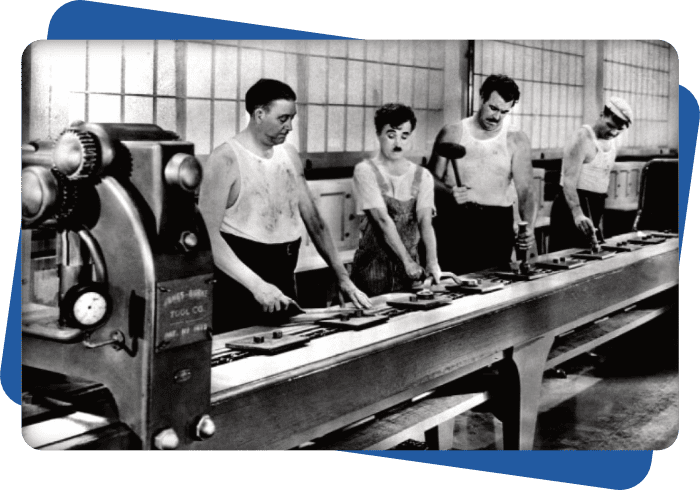The OCRA method
Occupational Repetitive Action “OCRA” is an evaluation method for analysing the exposure of workers to tasks with various risk factors for upper limb MSDs (repetitiveness, force, awkward postures and movements, lack of recovery periods, aggravating factors defined as “additional factors”).

For accurate and analytical risk assessments to be used in the design and improvement of operations and workstations.
For primary risk assessments, based on the preparation of risk mapping and the definition of a preliminary approach to risk management and mitigation.
For rapid and very approximate risk assessments, to be used in the preparation of risk maps in specific sectors.
The current OCRA method forms the basis of two technical standards (EN 1005-5) and ISO (ISO 11128-3).
In EN 1005 and ISO 11228-3, the OCRA method is chosen as the preferred method for detailed risk assessment because it takes into account all relevant risks.
The OCRA method is based on epidemiological data to analyse and predict the occurrence of MSDs (for exposed populations).
OCRA is observation-based and is primarily designed for use by company technical specialists (occupational safety and health operators, ergonomists, time and method analysts, production engineers).
The OCRA method is used in a wide range of industries and workplaces. It covers all jobs in the industry and the service sector that involve repetitive movements and/or efforts of the upper limbs (manufacture of mechanical components, electrical appliances, automobiles).
The body parts assessed are: hands, wrists, forearms and shoulders.
This method can be used to evaluate any work that involves movement and/or repetitive efforts of the upper limbs.
The main parameters analysed are:
Other “additional factors” are also taken into account, such as mechanical environmental and organizational factors.
In practice, OCRA is defined as:
OCRA index = Number of technical actions performed / Number of recommended technical actions

The OCRA index predicts the risk of work-related musculoskeletal disorders (MSDs) in the upper limbs.
The OCRA is the first reliable analytical method. It is generally used for (re)design or in-depth analysis of workstations and tasks (Colombini et al., 1998, 2002).
The OCRA is generally recommended for the examination of repetitive workstations (Colombini et al., 1998, 2002).
The OCRA index is the result of the ratio between the number of technical actions performed during a workstation and the number of recommended technical actions.
The “OCRA Checklist” method presented in the reference documents is a simplified method for the rapid assessment of the risks of physical overload of the upper limbs only.
The OCRA checklist is recommended for monitoring existing conditions. It makes it possible to map and identify hazardous work situations.
Only careful analysis of the activity can qualify and quantify risk factors such as the OCRA index.
This tool provides an initial mapping of the risk associated with repetitive work. This checklist determines what proportion of jobs or tasks can be classified as green (no risk), yellow (limited risk), red (medium risk), or purple (high risk). It can be applied quickly and does not include the specific analysis of each movement obtained with the OCRA index.
The OCRA checklist is a simplified procedure (compared to the OCRA index) to assess exposure to biomechanical overload of the upper limbs.
The scores are as follows :
The first step in the OCRA checklist method is to describe a job and estimate the intrinsic exposure level of the job(s).
Colombini D & Occhipinti E. [Results of risk and impairment assessment in groups of workers exposed to repetitive strain and movement of the upper limbs in various sectors of industry]. Med Lav. 2004;95(3):233-46.
Colombini D & Occhipinti E. Preventing upper limb work-related musculoskeletal disorders (ULWMSDS): new approaches in job (re)design and current trends in standardization. Appl Ergon. 2006;37(4):441-50.
Occhipinti E. OCRA: a concise index for the assessment of exposure to repetitive movements of the upper limbs. Ergonomics. 1998;41(9):1290-31 1.
Occhipinti E & Colombini D. [Proposal of a concise index for the evaluation of the exposure to repetitive movements of the upper extremity (OCRA index)]. Med Lav. 1996;87(6):526-48.
Occhipinti E & Colombini D. [The OCRA method: updating of reference values and prediction models of occurrence of work-related musculo-skeletal diseases of the upper limbs (UL-WMSDs) in working populations exposed to repetitive movements and exertions of the upper limbs]. Med Lav. 2004;95(4):305-19.
Occhipinti E & Colombini D. The occupational repetitive action (OCRA) methods: OCRA index and OCRA checklis. In: Stanton N, Brookhuis K, Hedge A, Salas E, Hendrick HW, eds. Handbook of human factors and ergonomics methods. Boca Raton, Florida: CRC Press 2005: 15:1-14.
Occhipinti E & Colombini D. Updating reference values and predictive models of the OCRA method in the risk assessment of work-related musculoskeletal disorders of the upper limbs. Ergonomics. 2007;50(1 1):1727-39.
Nawo Live is your physical activity risk assessment tool for identifying risk factors for musculoskeletal disorders (MSDs).
In Nawo Live, automate and evaluate all biomechanical risk factors using reference methods (RULA, REBA, NIOSH, etc.).
Nawo Live guarantees you a reliability of the measurements acquired by our systems, including :